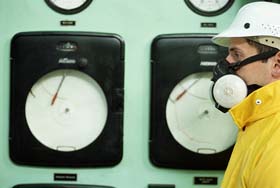|

|
|
| |
|
An
organization leader once remarked: "Our
process is so good that there is no way we
could make a mistake". The following
discussion on Design for Manufacturability
and Assembly (DFM/A) illustrates how we can
become so reliant on the process and process
improvement that we neglect the role of the
human in the process. ." A "Cadence
Chance" magazine article, "Design
for Manufacturability and Assembly"(DFM/A),
by Joe Greco defined DFM/A as "…any tool
or process that helps a designer or engineer
think about, and therefore avoid, manufacturing
and assembly problems down the road."We
have been asked how Error Management differs
from the process that is used in the DFM/A
as Error Management begins in the design process.
|
|
While it is true that Error Management begins in
the design process, it is not necessarily true that
the process will preclude error. Unfortunately,
in every process, humans are involved, and therefore
human errors will occur. We need to be constantly
reminded what Cicero the Roman philosopher, statesman
and orator said in 106 BC - 43 BC: "To
err is human, but to persevere in error is only
the act of a fool."The basic belief that a
thoroughly reviewed and understood process precludes
errors is a commonly shared belief. During Error
Management discussions we often hear many well-meaning
stories about the effectiveness of processes from
a variety of functional organizations. |
|
The title of the organization may vary; but the
common statement goes something like: "Our
organization is already using Error Management in
the process we use for start of the day or change
of shift meetings" It was at one of these discussions
where we heard the statement: "Our process
is so good that there is no way we could make a
mistake". Comments on our human tendency to
rely on the effectiveness of processes can be found
in even the highest levels of management.
When commenting on the loss of the Mars Orbiter
spacecraft, Dr. Edward Weiler, NASA's Associate
Administrator for Space Science said: "People
sometimes make errors. The problem here was
not the error, it was the failure of NASA's systems
engineering, and the checks and balances in our
processes to detect the error".
To mitigate too much reliance on processes, we and
our team members need to constantly reminded that
processes by themselves don't care. It is
the people who make the process a success or contribute
to failure. An organization may believe they
have the best process in the world; but it is the
humans that make it work or screw it up. With humans
in the process, they are subject to the limitations
in our personalities and the Traps in human nature
that are identified in Error Management training.
Error Management has a set of common sense, "nuts
and bolts" approaches to detect, avoid, mitigate,
and preclude reoccurrence of errors. Pearl
Buck, the Pulitzer prize winning author said:
"Every great mistake has a half-way moment,
a split second when it can be recalled and perhaps
remedied". Error Management provides Tools
to help individuals and teams to raise their level
of Situational Awareness so we can be aware of when
we are about to make a mistake.
|

|
Some
specific Error Management Traps (dependent on a number
of factors including the specific process and individual
members of the team) that can be associated with allowing
error in the process to go unresolved include: 1.
Excessive Professional Courtesy- The individual does
not feel free to question the validity of a process
because of reluctance to speak up to the team lead
or out of deference to the technical expertise of
the team lead or more experienced team members. 2.
Spectator Syndrome - The individual does not raise
questions he might have about the process as he assumes
that the process is completely valid because it has
been used many times before and has been thoroughly
reviewed prior to use by a competent team of individuals.
|
The
concern over individuals involved in a process was
amplified by Joe Greco in his "Cadence Chance"
magazine article on DFM/A when he said "The
subject of DFM/A cannot be discussed for too long
until words such as collaboration and team will
come up to help describe a system where engineers
talk to designers and manufacturers. However,
no matter how advanced the technology is allowing
these professionals to collaborate, the question
still remains whether or not they will, simply because
many engineers are used to going off on their own
to solve problems. Joe Greco went on to say:
"Miles Parker III, a DFM/A manager at the University
of Rhode Island feels that changing the thinking
of this "engineering culture" is a major
factor in successfully implementing a DFM/A system"Are
you relying too much on a process to catch errors?
Are you creating an environment where individuals
and teams feel free to speak up when they have concerns
or questions about a process? Error Management
can help create the right environment to meet your
needs and improve the bottom line.
- Larry Tew
|
 |
|
| © The
Center for Error Management 2004-2011
|
|